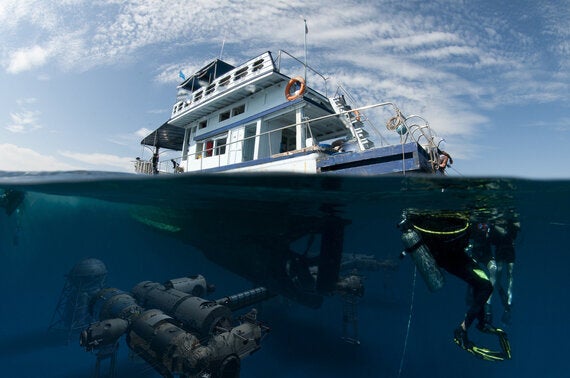
Forget the space race. Lately, it's the race to the seabed that's been capturing headlines around the world as China's Jiaolong submersible returned from its 118-day expedition in the depths of the Indian Ocean.
While the current focus of seabed studies is research and sample gathering, the long-term game is all about mining for precious minerals. But should we be allowing the pristine deep sea floor to be touched at all? With many different organisations currently probing up to 1.5 million square metres of the Indian and Pacific Oceans, how can we possibly hope to monitor and understand the ecological impacts of such actions?
A series of permanent underwater human habitats able to improve localized monitoring could be part of the answer.
To mine or not to mine?
Due to a lack of suitable technology, there's been a lack of activity in deep-sea mining since HMS Challenger first discovered seabed minerals in 1873. But huge investment in emerging technologies is likely to make commercial mining a reality within a few years.
Countries and commercial companies are interested in exploiting rich seafloor sources of cobalt, copper, nickel, silver, gold, vanadium, titanium, manganese and rare earth elements - all of which are essential ingredients of everyday life, from mobile phone batteries to surgical instruments, engines and TV screens. In some international waters lie billions of tonnes of metal-rich nodules, waiting to be gathered. So far, 26 permits have been issued to allow exploration.
Many argue that technological advancement - even the development of renewable energy technologies - will demand sub-sea sources of minerals. Executed responsibly, seabed mining could have less of an impact than its terrestrial counterpart. The complexity of the machinery required would likely ensure that it is a smaller-scale process, which would probably involve remotely operated vehicles and robots. And unlike mining on land, no roads or other infrastructure would need to be built in order to gain access.
Yet the Deep Sea Mining Campaign insists that deep-sea mining is being initiated "in the absence of regulatory regimes or conservation areas to protect the unique and little known ecosystems of the deep sea".
A study carried out between 2002 and 2007 estimated that there could be more than 1,000 species at a single site in the key region proposed for mining. According to the Global Ocean Commission, "mining at the seafloor will cause localized damage, including crushing living organisms, removal of substrate habitat and disturbance of sediment", with further environmental impacts during processing. They list rising demand for resources, technological advances and weak high seas governance as "drivers of decline" for the oceans.
The financial rewards may make deep-sea mining inevitable, but we still know precious little about this environment and its ecology. So shouldn't we be proceeding with more caution?
Towards more in-depth monitoring
Since 1994, the International Seabed Authority (ISA) is the intergovernmental body responsible for handing out permits for explorations like this one, organizing and controlling all mineral-related activities in the regions of the world's oceans not covered by any country's territory.
The ISA's 164 members (excluding the United States, who have not ratified the convention) work together to develop standards, regulations and guidance for seabed exploitation. It has also established nine protected areas in the Pacific where mining will be banned. But do its efforts go far enough?
While concerns about emerging powers China and India dominate headlines in the Western world, the United States is pushing forward with mining plans. In May, the Center for Biological Diversity launched a lawsuit against the U.S. government over its first-ever approval for large-scale deep-sea mining between Hawaii and Mexico. They say the project will damage important habitat for whales, sharks and sea turtles and wipe out seafloor ecosystems. Their challenge insists that environmental impact studies should be completed before exploratory permits are issued.
This month's G7 Summit discussed deep-sea mining, stating in their released Declaration that they had identified the need to enhance the effective protection of the marine environment from harmful effects as a key priority, requiring a "precautionary approach".
But that precautionary approach demands that more information is provided about preliminary operations beneath the surface.
Keeping tabs on development from beneath the waves
The Chinese submersible discovered new hydrothermal vents this year - unique ecosystems about which we have much to learn - and announced the gathering of huge amounts of data, samples and new species.
The first commercial mining license has already been granted to Nautilus Minerals, who are planning operations in the coastal waters of Papua New Guinea - a region that doesn't fall under the remit of the ISA. With the Pacific islands' waters as ground zero for deep sea mining activity, those countries should work together to develop strong regulations so that companies cannot choose waters with lax or no regulations to go mining in.

Although there are some rules and regulations in place, it remains unclear how ISA will monitor activity to ensure that they are adhered to thousands of metres beneath the oceans' surface? Is anyone truly quantifying the impact on the seabed?
My mission to develop a self-sustaining underwater habitat could help forge the infrastructure and technologies to make more in-depth monitoring possible. Forming a cooperative platform would unite industry and ecological research organisations with a permanent undersea community.
NASA's 2016 X-Hab Academic Innovation Challenge currently has research teams designing buildings, life support systems and technologies for "Beyond Earth Habitation". If we can create structures capable of supporting humans on Mars, it's easily conceivable that we could develop a sustainable sub-sea habitat here on Earth - perhaps even using the same approaches and technologies.
Working from a combination of static or moveable underwater habitats, inhabitants could accurately research how deep-sea marine ecosystems are affected by early explorations and initial mining activities. We continue to seek partners and sponsors eager to collaborate.
Images: Phil Pauley